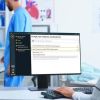Traditionally, the use of healthcare services begins with an in-person appointment with a primary care physician, but being seen often takes days or weeks. As a consequence of the evolution of information technology infrastructure, the ability to deliver digital access to healthcare services has developed. The advantages are many, including eliminating many emergency room visits, engaging and monitoring patients that live in remote locations, and bringing in specialist expertise. Adoption of digital services has been accelerated due to the COVID-19 pandemic worldwide. Both healthcare providers and patients sought safe ways to deliver and access healthcare services during the early period of the pandemic.
Below are three case studies using Siemen's Healthineers solutions.
Case Study 1: Andes Salud Clinics
The Andes Salud Clinics consists of four hospitals with 80 specialists operating in different regions of Chile, including remote areas.When the COVID-19 pandemic hit, physicians realised that they must reduce in-person contact to preserve their patients' and their own safety. The demand for telehealth services grew immensely because telemedicine could fulfil this need. To meet this demand, AndesSalud Clinics relied on the Siemen's Healthineers' eHealth Virtual Visit to connect physicians to patients who could not attend in-person consultations for safety. As much as 30% of appointments were conducted remotely during the pandemic's most challenging times.
Physicians also realised that telehealth could help physicians optimise their time and capacity allocation better. For example, specialities like psychiatry, nutrition, or psychology often do not need in-person appointments for a diagnosis and a treatment plan. Telehealth services could also help alleviate the emergency room burden by handling the medium- and low-complexity patients that previously went into emergency rooms. Telehealth services could increase physician availability to populations living in remote areas and attend to their health needs. Lastly, the convent care that telehealth services offer could help attract patients.
Case Study 2: Electronic HealthRecord Austria
In Austria, the ELGA (Electronic Health Record Austria) allows patients from Austria to view all their medical records anytime and anywhere.By supporting the information flow of medical information, ELGA is expected to improve the quality of diagnostics, therapeutic decisions, processes, and results along the treatment workflow. Patient safety is enhanced, while redundant tests and examinations and conflicting prescriptions are reduced.
The project is supported by Austria's federal ministry of health, different social insurance carriers, and the federal states. Siemens Healthineers Team play digital health platform provides the infrastructure for nationwide electronic health records (EHR) system in Austria. It meets the challenges of connecting different IT systems to the national infrastructure, inter-institutional data sharing, reducing redundant and conflicting prescriptions, and removing burdensome document management. Essentially, the system provides simple, convenient, and secure access to health data for patients and healthcare practitioners.
Case Study 3: HerzConnect® Care Program
Heart failure is the most common single diagnosis in Germany and incurs immense medical costs.As a result, half of heart failure patients receive optimal drug doses according to care guidelines. Frequently, heart failure is diagnosed by primary care physicians, with only a few patients cared for by cardiologists. Insufficient care issues are exacerbated in rural areas where long distances to care facilities and specialists are a factor. Chronic heart failure patients are often hospitalised and face poor treatment continuity after discharge because ineffective processes are involved in the transition to home settings. Thus, there is a high risk (30%) of readmission within the first 60 days.
The Herz Connect® care remote care program is intended to provide better home care to chronic heart failure patients. It is intended to improve their quality of life, increase and sustain independence, and develop self-management skills. Expertise at an inter regional centre can interact with chronic heart failure outpatients using home telemonitoring, data management, and data exchange. In this program, patients are equipped with vital-medical measuring devices (a scale,a blood pressure monitor, and a two-channel ECG system) and a specially configured smartphone with a telemedical app. Vitals are transmitted through Bluetooth to the smartphone, uploaded to the interregional centre, and integrated into the EHR. A physician can monitor these vitals to address any abnormalities that may develop. The telemonitoring also monitors patient compliance, which can signal the care team to intervene. Regularly administered heart-failure-specific questionnaires also assess the quality of life and self-management skills. The program also includes topic-based coaching sessions by telephone to help patients address their conditions.
References:
Siemens Healthineers (2021) Andes Salud Clinics improve access to telehealth services in Chile Available from cdn0.scrvt.com/39b415fb07de4d9656c7b516d8e2d907/67bf37922664fe8d/826b46d6d654/siemens-healthineers_dh_ehealth_virtual-visit_andes-salud.pdf
Siemens Healthineers (2021) ELGA – The Electronic Health Record in Austria. Available from siemens-healthineers.com/digital-health-solutions/teamplay-digital-health-platform
Siemens Healthineers (2020) Providing Post-acute Telemedical Care for Patients with Heart Failure. Available from www.siemens-healthineers.com/se/services/value-partnerships/asset-center/white-papers-articles/herzconnect-telemedical-care


















